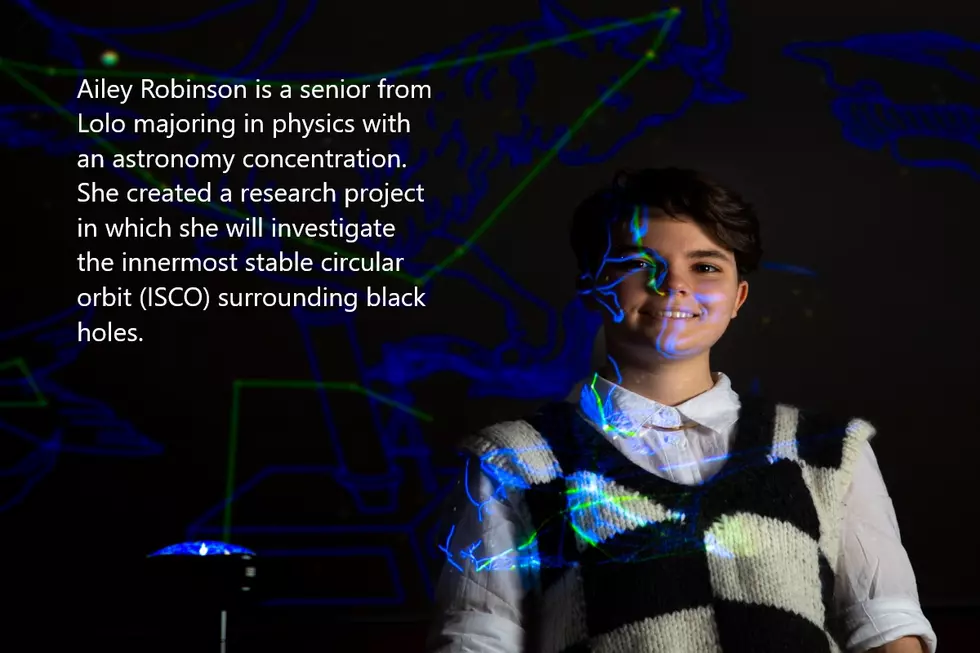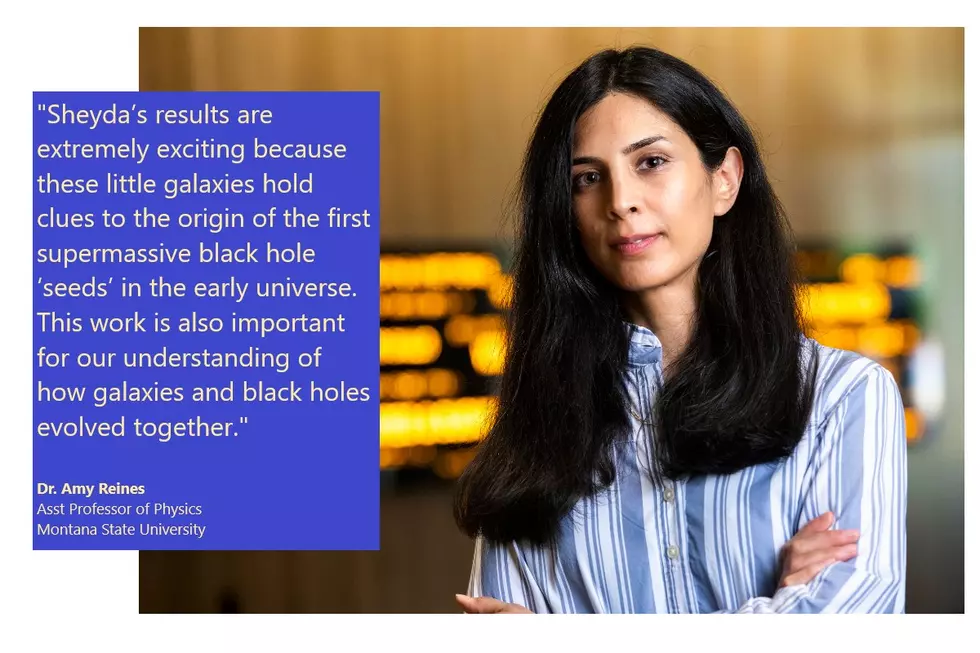
Illuminating Black Holes: Passion for Astrophysics Powers UM Student
MISSOULA – Lurking in the far reaches of outer space are immensely powerful dark monsters that eat entire star systems and swallow light itself. They are called black holes, and University of Montana student Ailey Robinson plans to conduct research this fall that adds to our knowledge of them.
Robinson is a senior from Lolo majoring in physics with an astronomy concentration. She created a research project in which she will investigate the innermost stable circular orbit (ISCO) surrounding black holes.
Nothing – not even light – can escape the immense gravity of these monsters. However, there is a point around each black hole, the ISCO, that is the smallest stable orbit for massive particles. Light there emanates from matter piling up right at the edge of an inescapable dark. And if it slips any lower … gulp!
“The ISCO is the lowest stable orbit of most particles around a black hole,” Robinson said. “As part of my project, I’ve created my own model to determine the ISCO.”
Her mentor for the project is Dr. Nate McCrady, a UM astrophysicist and professor in the Department of Physics and Astronomy. McCrady also leads UM’s involvement with MINERVA, a four-telescope array located in Arizona designed to hunt for planets around nearby stars.
Robinson said McCrady will help her test her model on a black hole whose ISCO is already known – perhaps the supermassive Sagittarius A* parked in the middle of our own Milky Way Galaxy. If her model holds up, she will work to figure the ISCOs for other gargantuan black holes at the center of galaxies.
Astronomers suspect a supermassive black hole like Sagittarius A* lurks at the heart of every large galaxy, but 10 million to a billion additional lesser black holes also may exist in our galaxy. The lesser black holes often are the superdense remnants of collapsed stars, but McCrady said scientists don’t yet understand the origins of the big ones found at the center of galaxies.
Robinson will use existing data instead of a telescope to work on her project.
“It’s so anticlimactic – just using a computer and crunching numbers,” she laughs. “I can work on this in my PJs on the couch watching a movie.”
Robinson said she and her sister were raised by parents who instilled them with an intense scientific curiosity. By the time she was a sophomore at Hellgate High School in Missoula, she was taking a science-fair-prep course called Advanced Problems in Science. That class required her to find mentors in her chosen area of interest – in this case astrophysics – so she reached out to Dr. Paul Janzen and McCrady in UM’s physics and astronomy department.
She wound up doing research with both UM researchers for several years before setting foot on campus as a college student. Establishing those relationships made her college choice easy.
“I think this shows a lot about Dr. McCrady’s personality and patience,” she said. “Even in high school – before I had braces! – he would go through the basics of how to do science with me. In the six years that I’ve known him, he invested a lot of time in me, shepherding my curiosity for science and helping me along. Who does that? And then at UM I’ve been able to take his classes every semester, which has been amazing.”
Robinson came to UM as a Presidential Leadership Scholar, earning one of the University’s most-prestigious four-year scholarships, and she enrolled in UM’s Davidson Honors College. Her department and the DHC require capstone projects to graduate, and she said her black hole project will satisfy both those needs.
“The PLS Scholarship just provides so much peace of mind with not worrying about student debt and loans stacking up,” she said. “It allows me to pursue my academic passions and truly give projects like this my all, especially one like this that I’m not getting paid for.”
Besides satisfying UM academic requirements, Robinson intends to use the black hole project to boost her resume for her next academic adventure. She would love to study with the GRAPPA (GRavition AstroParticle Physics Amsterdam) program in Europe.
“I’m hoping to get in there and spend a few years earning my master’s and then hopefully continue on to my Ph.D. after that,” she said.
But for now she has one more year to complete at UM. She said her older sister, Autumn Robinson, also attended UM for its STEM offerings and graduated last year with degrees in microbiology and geology. Autumn is now on the East Coast doing water-treatment research and earning a Ph.D.
Ailey Robinson said she has no regrets about taking an academic path to UM that now has her studying monstrous high-gravity celestial objects.
“I’m very biased at this point,” she said. “I’ve been treated so well by my professors and everyone in the Davidson Honors College. I think everyone should go to their smaller-town universities – especially for STEM.”
- by Cary Shimek, UM News Service -
More From K96 FM









